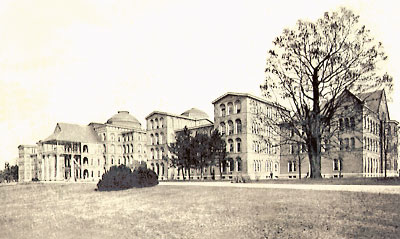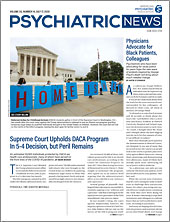Thomas Kirkbride, an APA founder, developed the prototype lunatic asylum and also set the stage for segregation in asylums: “The idea of mixing up all colors and classes, as seen in one or two institutions in the United States, is not what is wanted in our hospitals for the insane.” Following Kirkbride’s admonition, the United States progressed from segregation within facilities to totally separate asylums for Blacks.
Hospitals to Treat Black Patients
In 1861, the Alabama Insane Asylum opened in Tuscaloosa and admitted Black patients in segregated facilities. In 1866, Longview Asylum in Cincinnati built a separate structure, some distance from the main building, to care for Ohio’s “colored patients.” In 1864, the West Virginia Hospital for the Insane admitted its first white patients but did not admit its first Black patient until 1873. Missouri’s Fulton State Hospital reopened in 1863 after being used as a barracks for federal troops and placed its first Black patients in a separate “colored” wards in 1865. In 1866, a separate building for Black patients was added to the campus of the lunatic asylum in Milledgeville, Ga.
That same year, the Tennessee legislature appropriated funds for a separate building at the Eastern Tennessee Hospital for the Insane, labeling it an “asylum for colored insane.” These actions were the fulfillment of Francis Stribling’s ideal solution—a separate asylum for Blacks but under the management of the asylum for whites, thereby saving administrative costs. Stribling, also an APA founder, was superintendent of the Western State Lunatic Asylum in Staunton, Va. He believed that Black patients should be cared for in separate hospitals.
In 1869, Virginia opened the first asylum for Black patients near Petersburg. The Central Lunatic Asylum for the Colored Insane was an incremental step, but an important one for Southern states. In 1877, the Florida Hospital for the Insane opened in Chattahoochee with segregated wards. In 1880, North Carolina opened a separate asylum for the “colored insane” in Goldsboro. In 1882, the State Hospital for Nervous Diseases opened in Little Rock, Ark., with segregated wards as required by state law. In 1889, the East Mississippi Insane Hospital opened in Meridian, admitting Black patients only because it was mandated by the state to do so.
In 1902, Mount Vernon Hospital opened for the care and treatment of the “colored insane” in Alabama. A new facility opened at Spring Grove in Maryland after the Civil War and was initially racially integrated, but by the end of the 19th century, Black patients were placed in less desirable sections of the main building. In 1906, Spring Grove opened a “cottage for insane colored women.” Also in 1906, Louisiana built a hospital exclusively for Black patients in Alexandria to relieve overcrowding at the Louisiana Insane Asylum in Jackson. Because of the increasing numbers of patients of both races, the new facility soon had to admit both Black and white patients. In 1911, Maryland opened the Hospital for the Negro Insane in Crownsville. Many of the patients were moved there from the segregated sections of Spring Grove Hospital.
In 1913, South Carolina opened a Blacks-only facility and moved all Black patients from South Carolina State Hospital to the new Palmetto State Hospital. In 1919, Texas converted Rusk State Penitentiary into a hospital for the “Negro Insane” but started admitting whites when more beds were needed. In 1926, West Virginia opened Lakin State Hospital for Blacks “suffering from mental and nervous disorders.” In 1933, the Taft State Hospital for the Negro Insane opened in Oklahoma. That’s not that long ago—some of you have family members who were alive when the last segregated state hospital opened.
The Alleged Increasing Prevalence of Insanity in Blacks
Why were all these hospitals needed for Black people? The predominate explanation was put forward by probably the most racist of the APA presidents since the Civil War, T. O. Powell, superintendent of the State Lunatic Asylum in Milledgeville, Ga.
In his presidential address at the Annual Meeting of APA (then the American Medico-Psychological Association) in Baltimore on May 11, 1897, he took this fundamental position: “Before the [Civil War] there were, comparatively speaking, few negro lunatics. Following their sudden emancipation their number of insane began to multiply, and, as accumulating statistics show, the number is now alarmingly large and on the increase.”
Powell noted that “the ratio of insanity per million among the negroes has risen from 169 in 1860 to 886 in 1890.” The reason, he said, was the same one articulated 50 years earlier: “Following their emancipation, the negroes have become subject to the same penalties that other races have paid for liberty, license, and intemperance. Among those penalties insanity is not the least. … This progression is antedated by the period when the Southern negro was in a great measure exempt from … insanity.”
Powell informed APA members, “Those authorities who have given not only most thought to the subject, but who have also dealt with it practically in our asylums, have been unanimous in the opinion that the separation of white and colored patients is to the advantage of both races.” He told attendees that the “superintendents of a number of Southern hospitals of contiguous States in sympathy with each other, because they were subject to the same dangers, responsibilities, and duties,” formed the Association of Southern Hospitals for the Insane (ASHI) in 1893. The ASHI reported to the national association.
Reminding APA members about the ASHI and its purpose was somewhat self-serving as Powell was the president of both organizations. The ASHI received formal recognition from APA as the American Journal of Insanity (which was renamed The American Journal of Psychiatry in 1921) published its proceedings in a format similar to that of APA’s proceedings. At the second annual meeting of ASHI in 1896, J. F. Miller, the superintendent of the segregated asylum in Goldsboro, N.C., presented a lecture titled “Has Emancipation Been Prejudicial to the Mental and Physical Health of the Negro?” in which he covered the same ground he had in an article earlier that year in the North Carolina Medical Journal. Miller agreed with the view of many Southern psychiatrists of the preceding half century that insanity in Blacks was rare before the Civil War, although he articulated it more crudely than most, referring to each one as “a crazy negro.”
Miller shared Powell’s position that the alleged increase in insanity in Blacks was because Blacks could live comfortably “under less favorable circumstances than the white man, having a nervous organization less sensitive to his environments, yet it is true that he has less mental equipoise, and may suffer mental alienation from influences and agencies which would not affect a race mentally stronger.”
Miller and Powell were echoing the sentiment expressed when APA was formed that Black people were “primitive.” As Miller said, “A native of Africa and a savage a few generations ago, then a slave for several generations afterwards; this is the man and the race upon whom the high responsibilities of freedom were thrust.” These quotes come from Miller’s article. The journal reported only his talk: There is no record indicating that an APA member provided a rebuttal or asked why APA was allowing itself to be associated with such sentiments. The most likely reason was that keeping APA as a national organization trumped what many APA members thought would have been the right thing to do.
Miller also linked the characteristics of insane Blacks to the challenges in maintaining them in an asylum: “The negro laughs louder, sings louder, prays and preaches louder, than the Caucasian; and is more vulgar in speech and less cleanly in his person. He carries these characteristics into his insane condition and is therefore more noisy, more vulgar and beastly in his habits.” And consequently, there are “few colored attendants [who] have the necessary influence over the colored insane that is so desirable in their care and treatment.” Miller’s thoughts tainted psychiatry for decades.
In 1914, a white female psychiatrist at St. Elizabeths in Washington, D.C., wrote in the journal: “Only 300 years ago the negro ancestors of this race were naked dwellers on the west coast of Africa … in the depths of savagery and suddenly transplanted to an environment of the highest civilization, and 250 years later had all the responsibilities of this higher race thrust upon them, so that to preserve their existence in this environment of civilization, they were forced to make the products of their mental and manual efforts equal those of their competitors.”
They, of course, could not in the eyes of white people and hence insanity in Blacks. In 1921, a white male psychiatrist at the same hospital made the same argument in the journal and used almost the exact language. He went on to explain that Black children were healthy but “about puberty there begins a slowing up of mental development and a loss of interest in education as sexual matters and a ‘good time’ begin to dominate ... promiscuous sex relations, gambling, petty thievery, drinking, loafing, and a care-free, prodigal life, full to the brim with excitement, interspersed with the smallest possible amount of work.” The theme of “uncivilized” Blacks not having the wherewithal to manage freedom is expressed yet again in the journal in a 1953 article titled “Mental Health Among the Slave Population on Southern Plantations.”
Conclusion
If you were an APA member in the first half of the 20th century, the message that you would have repeatedly heard was that Blacks were of “savage origin,” unable to handle freedom, increasingly insane as a result, and in need of care in an asylum—and that care should be provided as far away from white patients as a state could manage.
In 1945, APA officially adopted standards for psychiatric hospitals. Among the multitude of “shoulds” in the document, nowhere to be found is “Psychiatric hospitals should be integrated.” ■
“Standards for Psychiatric Hospitals and Out-Patient Clinics Approved by the American Psychiatric Association (1945-46)” is posted
here.


